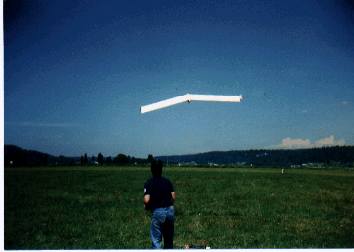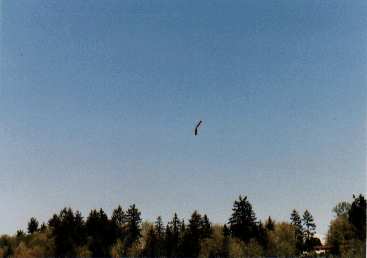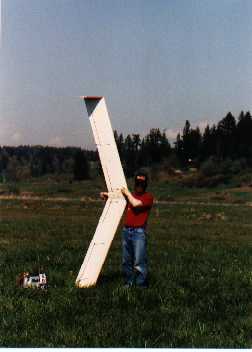 Penumbra.4 utilizes a constant chord wing and
the EH 1.0/9.0 airfoil. It has a shallow
fuselage, and construction is of foam and
fiberglass with a carbon fiber reinforced
spar. Other than the wing leading adge and
control surface faces, there is no wood in
Penumbra.4's construction.
Penumbra.4 utilizes a constant chord wing and
the EH 1.0/9.0 airfoil. It has a shallow
fuselage, and construction is of foam and
fiberglass with a carbon fiber reinforced
spar. Other than the wing leading adge and
control surface faces, there is no wood in
Penumbra.4's construction.
Test flying Penumbra by the hand toss method
was not completely successful. It is very
difficult to get sufficient speed, even while
running across the field into the wind and
throwing as hard as possible. In an effort to
get satisfactory glides from hand tosses, a
too large amount of up trim was put into the
elevons. The first winch launch attempt thus
ended in a veer to the right and a spin to
the ground. No damage was incurred, however,
so the wing-fuselage junctions were retaped
and some adjustments made. Elevon trim was
lowered by three clicks and the towhook moved
forward about 1.5 cm.
 The second and all subsequent attempts were
completely successful with no tracking
problems noted. While it should be possible
to reduce the elevon up trim and move the CG
and towhook locations rearward, achieved
launch height was completely acceptable.
Flaps were not used during tow.
The second and all subsequent attempts were
completely successful with no tracking
problems noted. While it should be possible
to reduce the elevon up trim and move the CG
and towhook locations rearward, achieved
launch height was completely acceptable.
Flaps were not used during tow.
Penumbra.4 seems to be very sensitive to
thermal activity, and was seen to be climbing
at significant rates while traveling in a
straight line. Thermal turns are a bit
different than what we had expected. Our
other elevon controlled 'wings, based on Dave
Jones' Blackbird design, have all required
opposite aileron to prevent spiraling in. Not
so Penumbra. Once aileron control is
neutralized this 'wing tends to come out of
the turn. A small amount of right aileron
must be input, therefore, along with a small
amount of up elevator, to maintain a right
turn.
 Penumbra.4's speed range is very broad. With
an approximate 10 knot breeze, it was
possible to approach a hover when flying into
the wind. A dive test to examine pitch
recovery showed excellent acceleration and
prolonged high speed flight in crosswind
conditions. Launch height attained through
zoom launches was very significant. Use of a
small amount of positive flap during a
landing approach showed the typical slight
nose up pitching tendency; this was easily
controlled with a small amount of down
elevator. Landing speed did not seem to be
affected with 20 degrees of flap deflection,
but approximately 60 degrees is available.
Penumbra.4's speed range is very broad. With
an approximate 10 knot breeze, it was
possible to approach a hover when flying into
the wind. A dive test to examine pitch
recovery showed excellent acceleration and
prolonged high speed flight in crosswind
conditions. Launch height attained through
zoom launches was very significant. Use of a
small amount of positive flap during a
landing approach showed the typical slight
nose up pitching tendency; this was easily
controlled with a small amount of down
elevator. Landing speed did not seem to be
affected with 20 degrees of flap deflection,
but approximately 60 degrees is available.
All winch launches were accomplished by means of strong tension on the line, vigorous throwing of the 'wing straight out, and continuous power to the winch motor through the zoom. Only one minor episode of flutter was experienced, that during a strong zoom when the towline failed to come off at the appropriate time. The flutter lasted for only a couple of cycles and was extremely well damped. We do not consider this episode indicative of a significant problem.

